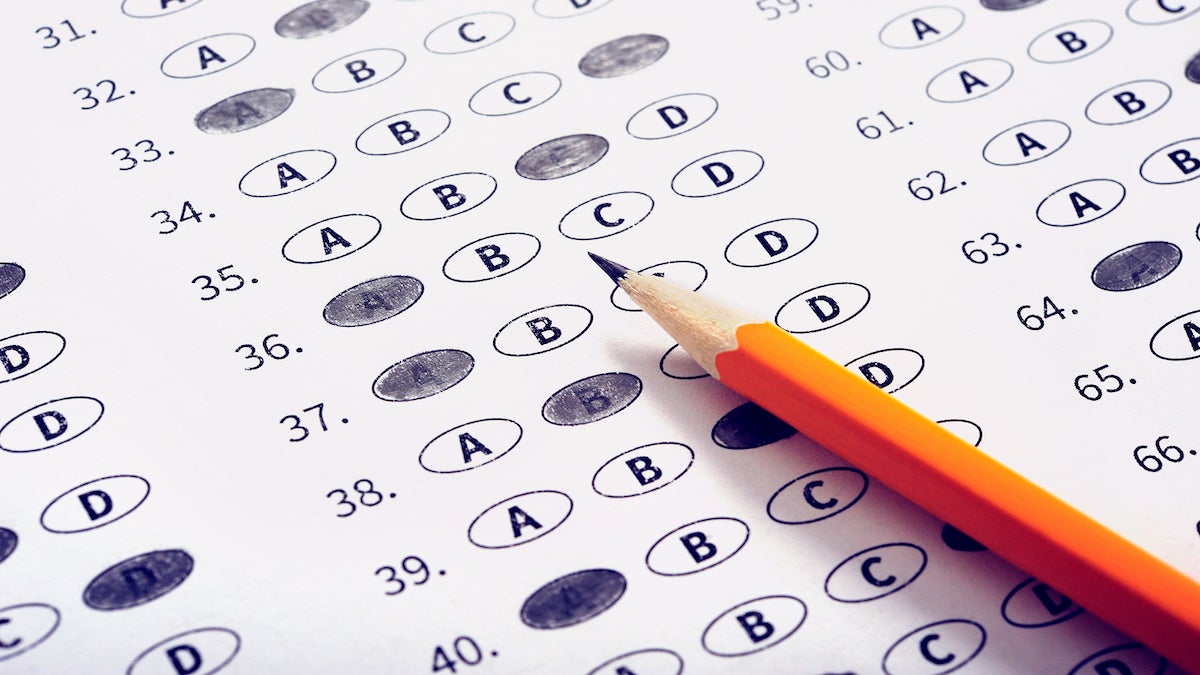Del. test scores show too many students behind in math, English

(Exam Test / BigStock)
Delaware students made incremental gains and losses this year in both English and math, and mostly lost ground in science, according to results of standardized testing released Thursday.
The results showed almost unanimous participation in the Smarter Balanced tests taken by third-through eighth-graders. That contrasted with lower-than-required participation by high school students in the Scholastic Aptitude Test (SAT) used by most colleges.
The statewide scores from the 2017 tests, compared with those from 2016, show that for students in grades 3 through 8:
• Math proficiency increased one percent, to 45 percent.
• English proficiency fell one percent, to 54 percent.
Proficiency in Smarter Balanced testing means that students are on a path to college and career readiness, said Michael S. Watson, chief academic officer at the state Department of Education.
Results of the SAT, which included juniors and for the first time seniors who had never been tested, showed:
• Math proficiency dropped two percent, to 29 percent. Students are considered proficient in math if they score 530 out of 800 possible points in the SAT.
• English proficiency was unchanged at 53 percent. A score of 480 out of 800 is considered proficient in English, which is officially known as Evidence-Based Reading and Writing.
Science proficiency scores using the Delaware Comprehensive Assessment System (DCAS) showed:
• 2 percent drops for fifth and eighth graders to 47 percent and 45 percent, respectively.
• No change for 10th graders, at 43 percent.
In 2015, the state scrapped the DCAS for third-through eighth-grade English and math and began using the Smarter Balanced test, which officials is contend is more connected to college and career preparedness.
Testing in 2017 also showed some minor gains at a handful of low-performing, high-poverty schools in Wilmington designated in 2014 as “priority schools.” Those schools continue to struggle mightily in standardized testing, though. For example, at Christina School District’s Bayard Middle and Stubbs Elementary schools, only 3 percent of students are proficient in math.
By contrast, the Laurel School District in western Sussex County achieved an 8 percent gain in elementary and middle school math. Laurel Middle School, a priority school, showed improved in math proficiency from 27 percent to 38 percent.
The results are preliminary, said Watson, who added that he doesn’t expect the results to change in any measurable way when finalized later this summer. Watson briefed media members on the results Wednesday on the condition that the numbers would not be made public until Thursday at 5 p.m. He added that testing results broken down by race, income and other categories would be unveiled in early August.
You can see see and search the state’s results by grade, school and district, and grad and other measures on the Department of Education’s website. Officials said the link should be up by 5 p.m. or soon after.
‘We have a lot of work to do’
Delaware had 137,2000 public school students in 2016-17. That’s nearly 10,000 more since the 2009-2010 year. The increase is a result of both population growth and a migration from expensive private schools to taxpayer-funded free charter schools such as high-performing Newark Charter, Sussex Academy, Conrad Schools of Science, Delaware Military Academy, Charter of Wilmington and Cab Calloway School of the Arts.
Watson acknowledged that the results were not optimal, saying it’s clear that serious improvements need to be made in Delaware with 55 percent of third through eighth graders below par in math and 46 percent behind in English. Nor is it acceptable when most kids score below average on the SAT.
“The bottom line is we have a lot of work to do,” Watson said. “Certainly the Department of Education is not masking that.”
Noting the SAT math scores, Watson added: “Right now in our system about 30 percent of our kids are ready to take college level courses and get a C or higher and do well. Which means we have 70 percent who don’t.”
Neither Heath Chasanov or Matthew Burrows, the current and immediate past presidents of the Delaware Chief School Officers Association, could be reached for comment. Chasanov is superintendent of Woodbridge School District and Burrows heads Appoquinimink.
Atnreakn Alleyne, executive of the education advocacy group Delaware Campaign for Achievement Now and a former top official in the Department of Education who studied assessment data, said the fact that the “numbers are stagnant” points to the longstanding problem of Delaware having a high percentage of children who lack the basic skills in math, English and science.
“We’re saying the bulk of our kids aren’t proficient,” said Alleyne, who learned about the 2017 results from contacts in education circles. “When you get to the student level, what does that mean year over year, not having some of the academic basics. It limits your trajectory, your opportunities.”
State “excited’ about 2-year gains
While Watson realizes that results this year are mediocre compared with last year, he stressed that for the elementary and middle school students, the two-year trend in math and English Language Arts since 2015 shows growth in both subjects.
The two-year proficiency results for grades 3 through 8 show:
• 4 percent growth in math.
• 2 percent growth in English.
Watson also noted that since more students are taking the tests, more are demonstrating proficiency.
For example, from 2015 to 2017 the number of students in grades 3 through 8 with proficiency in math grew by about 3,500, and in English another 2,500..
Also, students in the fifth and sixth grades — key transitional years between elementary and middle schools — improved in math by 6 percent and 7 percent, respectively, over the two-year period.
“We are really excited when see 3,500 more students are [on the path to college and career ready in mathematics,” Watson said.
“It’s also important that a lot of districts have really moved the needle” since 2015, he said, particularly noting western Sussex districts such as Laurel, Seaford, Woodbridge and Indian River.
While some educators and students, especially in low-performing schools, denounce the tests as unfair and unrepresentative of what a student really knows, Alleyne calls them critical assessments of their knowledge.
“Some of that is noise and some of that is nonsense,” Alleyne said. “These tests are certainly not measuring everything about a kid, of their grit and other skills. But they shine light on something important. They predict your readiness for the next level.”
Alleyne said he has worked with plenty of high school students who do fairly well in class but have mediocre test scores and then have a hard time in college.
“This means something,” he said. “I’ve seen enough students go through high school to college and struggle in college to know that this catches up to you in college and ultimately in life if you can’t write to the levels the Smarter Balance or SAT are expecting, or you can’t comprehend.”
Gov. John Carney, like Watson, took an optimistic view of the results statewide, but expressed grave concerns about low-scoring schools.
“With the help of educators across our state, more Delaware students are making real progress, and are on the path to long-term success,’’ Carney said in a statement.
“There are bright spots in this data, and many schools have made notable gains. It’s clear that teachers and school leaders are making a real difference in the lives of kids across Delaware.
“But the difficult truth remains that too many of our students in the City of Wilmington — our largest city and the economic and cultural engine of our state — are being left behind. That is something that we cannot allow to continue.
“We must do more to help our most disadvantaged students — those affected by poverty, stress, and trauma. … I intend to take real action to address this issue.”
WHYY is your source for fact-based, in-depth journalism and information. As a nonprofit organization, we rely on financial support from readers like you. Please give today.





